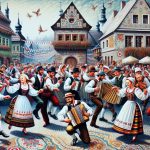
As Christmas comes around, Polish holiday music and carols really shine, showing off a big part of Polish culture. These songs, like ‘Wśród nocnej ciszy’ and ‘Bóg się rodzi,’ are key to Poland’s Christmas time. They mix religious respect, family love, and happiness within the community.
But to really get how special Polish Christmas music is, it’s worth looking into where these songs came from and how they’ve changed over time. These tunes connect with people of all ages, giving us a peek into what makes Polish holiday celebrations unique.
The Origins of Polish Carols
Polish carols, with their roots stretching back to the Middle Ages, represent a significant part of Poland’s cultural heritage. They are a unique mix of religious themes, local folklore, and historical elements. Originally, these carols were in Latin and focused on religious celebrations, reflecting the deep spirituality of that era. Over time, they evolved to include the Polish language and elements from everyday life, making them resonate more with the people. This change made the carols not just more accessible but also a mirror of Polish life and beliefs.
The transition from Latin to Polish and the incorporation of folk themes did more than just change the language. It also brought a rich diversity to the music of these carols. The melodies began to incorporate various regional musical styles, enhancing Poland’s cultural tapestry. For example, the carol ‘Lulajże Jezuniu’ combines a soothing lullaby melody with the profound reverence of the Nativity scene, showcasing the blend of folk and religious influences.
This evolution of Polish carols from strictly liturgical music to a more inclusive form that celebrates both faith and everyday life is a testament to the dynamic nature of cultural traditions. It shows how traditions can adapt over time, reflecting changes in society and in the ways people express their identity and beliefs.
In a broader sense, the story of Polish carols is a great example of how music can serve as a bridge between different eras and social changes. It highlights music’s power to preserve heritage while still embracing change, ensuring that traditions remain vibrant and relevant for future generations. Whether you’re listening to a carol from centuries ago or a modern adaptation, you’re connecting with a piece of Polish history and culture that has been cherished and passed down through the ages.
Celebrating With Traditional Melodies
In Poland, the festive season brings a special tradition that connects people not just to their faith but also to their cultural roots and community spirit. This tradition is singing Christmas carols, known as ‘kolędy’. These aren’t just any songs; they are a vital part of Polish Christmas, blending spirituality with historical narratives. Passed down through generations, these carols act as a bridge to Poland’s history, allowing every melody and word to tell a part of the Polish Christmas story. From the reflective atmosphere of the midnight mass to the warmth of family reunions, these carols capture it all.
What makes these carols stand out is their ability to convey the essence of Christmas in Poland. They echo the nativity story but also weave in themes of winter’s charm and local folklore. For example, one popular carol, ‘Bóg się rodzi’, combines references to the birth of Jesus with imagery of the starry night sky, illustrating the blend of sacred and folk traditions.
These carols are more than just seasonal music; they are a cherished cultural heritage that Poles are keen to keep alive. Singing them is a way to honor the past while celebrating the present. It’s a practice that strengthens bonds among families and communities, highlighting the importance of maintaining traditions in a modern world.
Modern Twists on Classic Tunes
In Poland, the tradition of Christmas carols is evolving in a fascinating way. Artists from a wide range of musical backgrounds, including pop and electronic music, are reimagining these classic tunes. By incorporating modern harmonies, rhythms, and instruments, they’re making these carols appealing to a new generation without losing the essence of the originals. This innovative approach connects the past with the present, showing how Poland’s Christmas music can adapt and thrive in today’s music scene.
For example, consider a traditional Polish carol like ‘Bóg się rodzi’ (‘God is Born’). In its original form, it’s a solemn, majestic hymn sung in churches and homes across Poland during the holiday season. Now, imagine it reworked with electronic beats, a dynamic bass line, and layered synthesizers, bringing a completely new energy while maintaining its core message. This isn’t just a hypothetical scenario; artists are doing exactly this, creating versions of these carols that resonate with younger listeners while still being recognizable to those who cherish the traditional renditions.
This trend isn’t just about music; it’s a bridge between generations. Grandparents and grandchildren can now share the joy of these carols in a new way, finding common ground in the updated versions. It’s a beautiful example of how traditions can evolve and adapt, ensuring they remain a vibrant part of cultural celebrations.
Moreover, this movement highlights the creativity within Poland’s music scene. These artists aren’t just covering old songs; they’re engaging in a creative dialogue with history, adding their unique voices to a centuries-old tradition. It’s a testament to the power of music to connect us to our past while also pushing us forward into new realms of expression.
In a world where music is constantly evolving, the modernization of Polish Christmas carols is a reminder of the enduring appeal of these songs. They’ve stood the test of time not just because of their melodies or lyrics, but because they represent something deeper about the human experience: a sense of joy, togetherness, and spiritual reflection that resonates across ages. By embracing both the old and the new, Poland is keeping its musical heritage alive and relevant for future generations.
Iconic Polish Christmas Songs
In Poland, Christmas is a time when music fills the air, bringing with it a sense of tradition and unity. Among the many Christmas songs, ‘Wśród nocnej ciszy’ and ‘Bóg się rodzi’ are particularly special. These songs are not just tunes; they are stories, telling us about Poland’s past and the true spirit of Christmas.
‘Wśród nocnej ciszy,’ or ‘In the Still of the Night,’ captures the peaceful and reflective mood of Christmas Eve. It’s a song that makes you feel like you’re part of a centuries-old tradition, joining generations of Poles who have celebrated this moment. The melody is soothing, and the lyrics speak of the night Jesus was born, inviting everyone to come and see the miracle. It’s a reminder of the religious roots of Christmas and the joy it brings to families as they gather together.
On the other hand, ‘Bóg się rodzi’ or ‘God is Born’ is more majestic. It has a powerful melody that fills you with a sense of awe. The song tells the story of the birth of Jesus in a way that reflects Poland’s history. It’s a blend of faith and patriotism, showing how Christmas is not just a religious celebration but also a time to feel proud of one’s heritage. This carol resonates deeply with many Poles, reminding them of their country’s journey through tough times and their collective hope for peace and unity.
Both of these songs are more than just Christmas carols; they are a vital part of Poland’s cultural identity. They bring families and communities together, creating a shared experience that is both personal and collective. Singing these songs, people not only celebrate Christmas but also connect with their history and each other.
Cultural Significance and Traditions
Polish Christmas music and carols play a crucial role in celebrating the country’s identity and traditions. These songs are more than just holiday tunes; they are a reflection of Poland’s history, showcasing the nation’s endurance and shared memories. For example, carols like ‘Wśród nocnej ciszy’ and ‘Bóg się rodzi’ are not just about the religious aspect of Christmas. They also capture the core of what it means to be Polish, highlighting the country’s spirituality and values.
These carols do more than just set the festive mood; they bring families and communities closer together. When people sing these songs, they feel connected to each other, creating a strong sense of unity. One beautiful tradition is ‘kolędowanie,’ where groups go from one house to another, singing carols. This practice is not just about spreading holiday cheer; it strengthens the bonds between neighbors and keeps the community spirit alive during the Christmas season.
To make this experience even more immersive, some communities organize caroling events, inviting everyone to join in. These gatherings often feature traditional Polish Christmas foods, adding another layer of cultural significance to the celebration. For those interested in exploring Polish Christmas music further, numerous albums and playlists are available that compile the most beloved carols, offering a glimpse into this rich tradition.
In essence, Polish Christmas music and caroling traditions are a vibrant expression of national pride and communal connection. Through the simple act of singing together, people reinforce their cultural identity and celebrate the enduring spirit of their community.
Conclusion
Polish Christmas music really brings out the spirit of the holiday season, connecting people to their culture and history. It’s not just about the catchy tunes; these songs hold stories and traditions that have been passed down through generations.
From the old-school carols to the newer versions, each piece showcases the changing and lively Polish culture. It’s amazing how these songs have become a key part of celebrating Christmas in Poland, helping to keep the culture alive and shared among families and friends.
So, when you hear a Polish Christmas carol, remember it’s more than just music; it’s a bridge to the past and a way to keep the community’s heritage going strong.






Comments are closed.